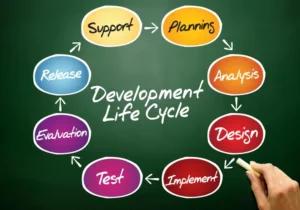This calls for good facilitation, and that calls for excellent agile facilitators. Relevant roles include ScrumMasters, Agile Project Managers, Agile Coaches, aspiring coaches, Product Owners, Business Analysts, and anyone with the desire to explore the power of facilitation. This course will guide students through the role of the facilitator and the mindset needed as well as the skill set, techniques, and practice it takes to become an effective ATF. Participants will develop an appreciation for the art of facilitation as key to fostering collaboration and enabling self-organizing teams. A number of training organizations conduct specialized team facilitator courses. In these, the trainees learn the necessary skills for the agile team facilitator.
The problem is simple, the options are few, there is little risk and everyone in the team understands and recognises the problem. It is far less straight forward when the issue is complex, and people have different views and perspectives. This is also a quick way to gain team consensus especially when a team needs to choose a few options from a large pool of options. I often use this in combination with Affinity mapping to work out which actions or ideas the group should work on first. Each team member is given the same number of dot votes ( 3 or 5) and places their dots on the idea they feel is the most important. When everyone has voted, you assess the results to facilitate agreement on the rank order of ideas or actions to work on.
Design and explain the coaching contract with your team and stakeholders
Respecting others means listen carefully to all views and not taking sides. Not jumping to conclusions, speaking to others respectfully and with appreciation. Embodying openness and https://www.globalcloudteam.com/ enthusiasm means being aware of our own pre-conceived ideas, prejudices, and biases. It means not interrupting others when we do not agree with them and assuming positive intent.
- Such as powerful questions, active listening, creating coaching alliances and contract, and how to give and receive feedback in an intelligent and constructive way.
- You will learn how to generate sustainable agreements within teams and organizations, raising your awareness about harmful false solutions that hinder the necessary self-organization in high-performance teams.
- Part of being a servant leader is to be approachable and be open to other people’s perspective.
- Good, lightweight facilitation can help the Scrum Teams get back on track.
- They would prepare the agenda, make clear the goal of the event, get the meeting started and provide the coaching and guidance needed to keep the meeting on track and focucsed on the goal.
Preparation is key to the success of your event, and we’ll walk you through it, step by step. Scrum Masters, Agile coaches, Lean experts, team coach, project managers, managers working in an agile environment. Professional training or an agile course should help give the facilitator a workable framework from which to draw the guidelines. Whether it’s to review a budget, discuss the next marketing campaign, or simply come up with the next competent team leader. It’s important to note that Agile team facilitation is not a one-time or occasional activity but rather a continuous process of guiding, supporting, and helping the team to improve and deliver value. Inadequate collaboration between team members and bureaucratic procedures can lead to poor outcomes and meltdowns.
Course Program ICP-ATF Certification
Yes, it aids with getting the discussion instigated, and it can bring meaningful outcomes as well. Even it will help with setting up learning objectives for the teams. For instance, when you follow this technique, your team will start thinking about retrospectives against pre-requisites alone. Helping teams self-organize and achieve useful collaboration requires the ability to plan and conduct effective team working sessions and meetings. The Agile Team Facilitator (ATF) role is crucial in helping teams achieve this higher level of agile maturity. The ATF also helps the teams with the mindset shift necessary to achieve true agility.

Take note of the current working methods, the level of discourse, and interpersonal relationships to find areas for improvement. Additionally, take note of the methods used by teams to overcome obstacles, reach decisions, and provide everyone an opportunity to be heard. Facilitating meetings is only one aspect of being an Agile team facilitator.
Starting with Scrum: 1 – Starting with a New Product
A facilitator with a high-level of understanding of the subject matter makes the Agile facilitator much more effective and trustworthy for the participants. Therefore, it is necessary to have the agile facilitation right skills to be an effective facilitator of an Agile environment. In many cases, meetings with highly skilled and agile team leaders running the show tend to achieve the agreed-upon outcomes.

The facilitator’s responsibility is to help participants do so effectively. Let’s look at a facilitation example during a meeting using convergent and divergent thinking. That is why it is important to set goals, outline boundaries (set rules), ensure accountability, and communicate with others. It’s crucial to believe in team professionalism for the team to grow and mature. A facilitator must be able to keep the meeting focused on achieving the outcome identified at the outset.
Do’s & Don’t. Tips for a First Time Agile Coach
Next they share in pairs and have a conversation about the questions posed by the facilitator. They then inspect the answers with another pair to form a group of four. Finally, each group then provides a summary of the ideas discussed and the learning outcomes for the session. This pattern can also be used is also great for generating action items at retrospectives. There are many facilitation techniques that can be employed to improve the Scrum Event interactions between team members and enhance the team’s success.
When used in running workshops, agile principles will call for the use of stress-tested processes such as Release Planning to ensure success. For the most part, these processes embrace specific rules to make sure everyone is done faster. With this kind of speed and structure, many professionals may feel compelled to use profession-specific jargon to cut down on talk time and increase the speed of communication. To do this, the agile team facilitator must have extensive knowledge of the employees and workplace behavior. As such, having a professional or practical background in organizational or occupational psychology can be quite helpful.
How active facilitation can improve participation in your (remote) meetings
Mitigating and preventing those types of meetings is one of the primary goals of facilitation. Nowadays, facilitation techniques are an essential toolkit for a good manager, whether you’re using Agile or classic techniques. In this article, we discuss facilitation theory and structure, who facilitators are, as well as their key skills, techniques, and responsibilities.
Part of being a servant leader is to be approachable and be open to other people’s perspective. Keep people’s secrets if they indicate a conversation is confidential. You build trust by building a professional relationship with your team. You build trust by being in Integrity with your word, which means doing what you say you are going to do and communicating when circumstances change. Trust is also built by being an example of accountability, integrity, and trustworthiness.
Defining Done: A Guide for Continuous Value Delivery
The ATF must also guide the team through the paradigm shifts required in Agile team environments and lead them towards collaboration and self-organization. To do so requires a mindset shift for the team leader – the facilitator mindset. Agile facilitation calls for forward-thinking, planning, and, in many cases, agility. The most adept agile facilitators employ a number of tips and tricks, mostly learned from agile practices and principles. As far as facilitation skills go, this one is one of the most difficult to master, especially when dealing with tense, agile team environments. Agile facilitation, therefore, is the art of ensuring that agile team objectives are met during an agile team meeting.
